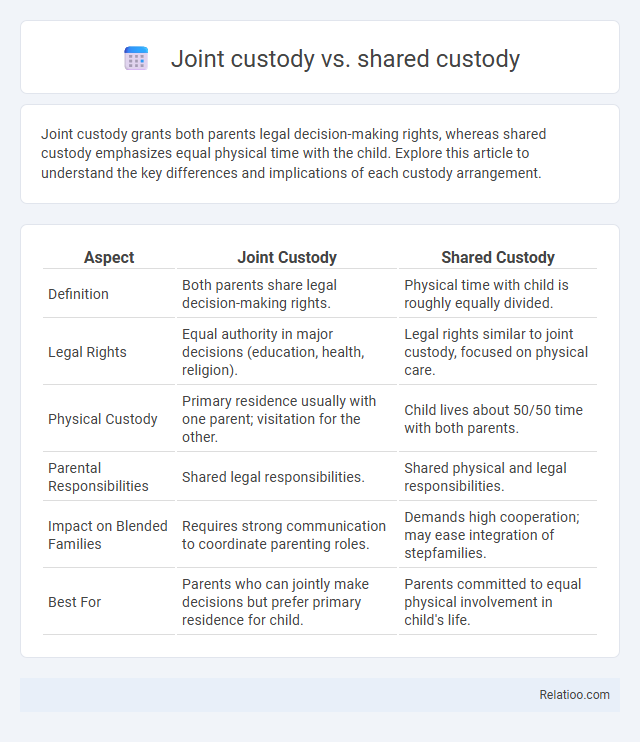Joint custody grants both parents legal decision-making rights, whereas shared custody emphasizes equal physical time with the child. Explore this article to understand the key differences and implications of each custody arrangement.
Table of Comparison
| Aspect | Joint Custody | Shared Custody |
|---|---|---|
| Definition | Both parents share legal decision-making rights. | Physical time with child is roughly equally divided. |
| Legal Rights | Equal authority in major decisions (education, health, religion). | Legal rights similar to joint custody, focused on physical care. |
| Physical Custody | Primary residence usually with one parent; visitation for the other. | Child lives about 50/50 time with both parents. |
| Parental Responsibilities | Shared legal responsibilities. | Shared physical and legal responsibilities. |
| Impact on Blended Families | Requires strong communication to coordinate parenting roles. | Demands high cooperation; may ease integration of stepfamilies. |
| Best For | Parents who can jointly make decisions but prefer primary residence for child. | Parents committed to equal physical involvement in child's life. |
Understanding Joint Custody
Joint custody involves both parents sharing legal decision-making responsibilities for their child, ensuring mutual involvement in education, health care, and welfare matters. Unlike shared custody, which emphasizes an equitable division of physical time with the child, joint custody centers on collaborative parental authority regardless of living arrangements. Understanding joint custody is essential for fostering cooperative co-parenting and maintaining consistent parental influence in a child's upbringing.
Defining Shared Custody
Shared custody refers to a parenting arrangement where both parents actively participate in making major decisions and spending significant, often equal, time with their child. Unlike joint custody, which primarily focuses on shared legal responsibilities, shared custody emphasizes both legal and physical custody with balanced parenting time. This structure promotes consistent involvement from both parents in the child's daily life and upbringing.
Key Differences Between Joint and Shared Custody
Joint custody refers to both parents sharing legal decision-making responsibilities for their child, while shared custody typically involves dividing the child's physical time between both parents more equally. The key difference lies in the scope: joint custody emphasizes legal rights and responsibilities, whereas shared custody focuses on the physical living arrangements and time spent with each parent. Understanding these distinctions helps you navigate custody arrangements that best support your child's needs and your parental involvement.
Legal Framework for Custody Arrangements
Joint custody typically refers to both parents sharing legal decision-making rights, allowing equal input on major issues such as education, healthcare, and religious upbringing, as defined by family law statutes in most jurisdictions. Shared custody often combines legal and physical custody, requiring parents to divide time and responsibilities more evenly, with specific guidelines set by state or national custody laws to ensure the child's best interests. Legal frameworks emphasize clear definitions and enforceable agreements to minimize conflicts and establish parental responsibilities, with court systems prioritizing arrangements that promote stability and ongoing parental involvement.
Parental Rights and Responsibilities
Joint custody and shared custody both involve parents sharing parental rights and responsibilities, but joint custody typically refers to both legal and physical custody, allowing parents to make major decisions together and split time with the child. Shared custody often emphasizes equal or nearly equal physical custody time, promoting balanced involvement in daily care while maintaining joint legal decision-making authority. Parental rights in these arrangements include participation in education, healthcare, and religious decisions, while responsibilities encompass providing emotional support, financial care, and ensuring the child's well-being.
Impact on Child’s Wellbeing
Joint custody and shared custody arrangements both aim to maintain strong parental involvement, but joint custody typically refers to shared decision-making responsibilities, while shared custody focuses on equal or nearly equal physical time with the child. Your child's wellbeing benefits most from consistent routines, emotional stability, and cooperative parenting regardless of the specific custody label. Research indicates that minimizing parental conflict and ensuring both parents remain actively engaged in your child's life are crucial factors for positive developmental outcomes.
Decision-Making Authority in Custody Types
Joint custody typically refers to shared decision-making authority between both parents, allowing you to collaboratively address important aspects such as education, healthcare, and religious upbringing. Shared custody generally emphasizes equally divided physical time, but decision-making authority can vary depending on the legal agreement or court ruling. Legal custody clarifies who holds the decision-making power, which can be joint or sole, impacting how major decisions about the child's welfare are managed.
Time Division and Parenting Schedules
Joint custody often refers to both legal and physical custody, where parents share decision-making responsibilities and your child's time is divided based on a mutually agreed schedule. Shared custody typically emphasizes nearly equal physical time spent with each parent, ensuring your child experiences balanced parenting schedules throughout the week or month. In contrast, sole custody grants one parent the majority of physical time, with the other parent having limited visitation, affecting how your child's daily routines and time division are structured.
Factors Courts Consider in Custody Awards
Courts consider several key factors in custody awards, including the child's best interests, which encompass emotional bonds with each parent, each parent's ability to provide a stable environment, and the child's needs, such as education and healthcare. Joint custody involves both parents sharing legal and physical custody, with courts evaluating cooperation levels and willingness to co-parent effectively. Shared custody, often used interchangeably with joint custody, emphasizes equitable time distribution, while sole custody is awarded when one parent can better meet the child's needs or when there's evidence of neglect or abuse.
Choosing the Best Custody Arrangement
Choosing the best custody arrangement depends on your child's needs and the ability of both parents to cooperate effectively. Joint custody allows parents to share decision-making responsibilities, while shared custody typically involves equal physical time with the child, promoting balanced involvement from both caregivers. Evaluating factors like communication, geographic proximity, and the child's preferences helps determine whether joint custody or shared custody best supports your family's well-being.

Infographic: Joint custody vs Shared custody
 relatioo.com
relatioo.com